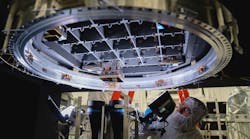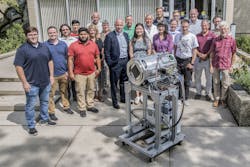After 16 years of dedicated planning and engineering, researchers at the U.S. DoE’s Brookhaven National Laboratory have completed a 3.2 gigapixel sensor array (film) for the camera that will be used in the Large Synoptic Survey Telescope (LSST), a huge telescope that will bring the universe closer than ever.
“This is the biggest charge-coupled device (CCD) array that has ever been built,” says Paul O’Connor, senior scientist at Brookhaven Lab’s instrumentation division. “It’s three billion pixels. No telescope has ever put as many sensors into one camera.”
The digital sensor array is composed of about 200 16-megapixel sensors, divided into 21 modules called “rafts”. Each raft can operate on its own, but when combined, they can capture an area of sky that contains more than 40 full moons in a single image. Researchers will use computers to stitch these images together to create time-lapse movies of the visible universe as seen from Chile.
The Large Synoptic Survey Telescope (LSST) is a wide-field survey reflecting telescope with an 8.4-meter primary mirror currently under construction in Chile. Once completed, it will be able to photograph the entire available sky every few nights.
The LSST telescope and camera are a joint effort of more than 30 institutions from around the world, and they are primarily funded by the DoE. SLAC National Accelerator Laboratory leads the effort to construct the camera—the world’s largest camera for astronomy—while Brookhaven led the design, construction, and qualification of the digital sensor array—the camera’s “digital film”.
Brookhaven began its LSST research and development program in 2003, with construction of the digital sensor array starting in 2014. In the time leading up to construction, Brookhaven designed and fabricated the assembly and test equipment for the science rafts used both at Brookhaven and SLAC. The Laboratory also created an automated production facility and cleanroom, along with production and tracking software.
The lab automated as much of the production facility as possible. Still, testing a single raft can take three days. The complex sensor array operates in a vacuum and must be cooled to −100°C. But the Brookhaven team also had to test each fully assembled raft, as well as individual sensors and electronics. Once each raft was complete, it needed to be carefully packaged and shipped across the country to SLAC.
Unfortunately, the team discovered the design was letting some of the rafts’ wires short out. This was only happening at a rate of about 0.2%, but to avoid loss of any resolution or accuracy of the telescope, the team refit almost every raft to do away with the risk.
Members of the LSST project team at Brookhaven Lab are shown with a prototype raft cryostat. In addition to the rafts, Brookhaven scientists designed and built the cryostats that hold and cool the rafts to −100°C.
Now, two years after starting production, the team has built and shipped the final raft to SLAC for integration into the camera. This marks the end of a 16-year project at Brookhaven. But Brookhaven Lab will continue to play a strong role in LSST going forward. As the telescope undergoes commissioning, Brookhaven scientists will serve as experts on the camera’s sensor array in the camera. They will also provide support during LSST’s operations, which are projected to begin in 2022.
Once operational in the Andes Mountains, LSST will serve nearly every subset of the astrophysics community. Perhaps most importantly, LSST will let scientists investigate dark energy and dark matter—two puzzles that have baffled physicists for decades. It is also estimated LSST will discover millions of asteroids in our solar system. Images captured by LSST will be made available to physicists and astronomers in the U.S. and Chile immediately. Over time, the data will be made available to the public worldwide.



